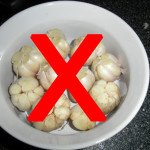A low FODMAP diet (news & events below)
Often I mention a low FODMAP diet to someone, there’s a pause and a curious expression. You mean, a low FAT diet? Can you say that word again? Although a low FODMAP diet hasn’t become a household word the way gluten-free has, there’s an impressive amount of research supporting it for people with tummy troubles of all sorts, especially IBS or IBD (Crohn’s, Ulcerative Colitis) and SIBO (Small Intestinal Bacterial Overgrowth). Obviously, this is pretty relevant to many people who are gluten sensitive or have Celiac disease and still have stomach distress.
So let’s break down the basics. FODMAPs is an abbreviation for Fermentable  Oligosaccarides, Disaccarides, Monosaccarides and Polyols. Unless you’re a food scientist, that likely means very little. In a nutshell, FODMAPs are carbs that certain people have trouble digesting, so they ferment in the gut and can cause all sorts of obnoxious symptoms. They cover a wide range of foods, like wheat, beans, garlic and onions, and many kinds of fruits and veggies.
Oligosaccarides, Disaccarides, Monosaccarides and Polyols. Unless you’re a food scientist, that likely means very little. In a nutshell, FODMAPs are carbs that certain people have trouble digesting, so they ferment in the gut and can cause all sorts of obnoxious symptoms. They cover a wide range of foods, like wheat, beans, garlic and onions, and many kinds of fruits and veggies.
Wait, wait, what? So now fruit, garlic and beans are bad for you? Thankfully, no. Foods with FODMAPs are not “bad” or unhealthy foods, just foods that can provoke symptoms in some people who have digestive issues. It’s a diet designed for GI symptom management, rather than something that’s globally healthier.
The good news is that reducing these FODMAPs help about 75% of people with IBS problems. I’ve been amazed and delighted at how much a low FODMAP diet helps reduce symptoms in clients I’ve worked with. Interestingly, studies have suggested that some people with stomach issues that have learned over time that they are gluten sensitive actually respond more fully to a low FODMAP diet than just a gluten-free diet. There’s speculation that for some, the key problematic component in wheat isn’t really gluten, but a fermentable carb called fructans. We’ll definitely be hearing more about that in the next few years.
The quick and dirty explanation of how a low FODMAP diet works: we do an  elimination diet where the main sources of FODMAPs are eliminated, and that means eating “allowed” foods in allowed amounts for a few weeks. Most people notice significant improvement after only a few weeks, and then we begin a structured reintroduction to see which classes or kinds of FODMAPs are actually triggering a reaction. The goal at the end of the day, of course, is to minimize symptoms while keeping as many foods on the table as possible. And yes, potatoes are allowed, and these guys are from my garden! Aren’t they cute?
elimination diet where the main sources of FODMAPs are eliminated, and that means eating “allowed” foods in allowed amounts for a few weeks. Most people notice significant improvement after only a few weeks, and then we begin a structured reintroduction to see which classes or kinds of FODMAPs are actually triggering a reaction. The goal at the end of the day, of course, is to minimize symptoms while keeping as many foods on the table as possible. And yes, potatoes are allowed, and these guys are from my garden! Aren’t they cute?
I have a more through review on a low FODMAP diet here from Simply Gluten-Free Magazine However, I’d strongly encourage you to NOT go this one on your own–between the foods allowed/disallowed, the quantity and spacing and the many incomplete lists on the Internet, it’s just not worth it. There are nutrition professionals, including myself, of course, around the world that are specially trained on teaching a low FODMAP diet at www.ibsfree.net so you can find a nutrition professional locally. If there isn’t someone near you, many nutritionists, including myself, consult over the phone or Skype.
There are a couple of great books & resources to get you started:
- IBS Free at Last (2nd edition) by Patsy Catsos, MS, RD
- The Complete Low-FODMAP Diet: A Revolutionary Plan for Managing IBS and Other Digestive Disorders by Sue Shepherd, PhD, RD and Peter Gibson, MD
- Kate Scarlata’s blog is fantastic, and has many great resources
- Got a smart phone? Look for the Monash University “Stop light” app
Also, for Kate Scarlata and Patsy Catsos are training nutrition professionals, and there’s one coming up Oct 17th in Atlanta before FCNE. I think they do a terrific job making the information interesting and accessible!
News:
- The gluten-free labeling legislation is out–finally! More on what it means here.
- Beware of…yeast extract? New tests show that this common ingredient may contain a significant amount of gluten.
- The Washingtonian shared one of my favorite summertime recipes: Lemony Mint Quinoa.
- Many of you know I’m a huge advocate of meditation and mindful eating. One of my articles, Treatment of Binge Eating Disorder Using Mindful Techniques is in this issue of Sports, Cardiovascular and Wellness Nutrition DPG Summer 2014
- I’m speaking on MS and nutrition in Vienna next Weds the 13th, which prompted me to write a post on autoimmune disease and nutrition.
Cheryl Harris, MPH, RD is a Registered Dietitian Nutritionist and Certified Wellcoach in Fairfax & Alexandria, VA. She helps people with a range of dietary issues , including Celiac Disease, GI issues, food allergies, pregnancy, breastfeeding, vegetarian and vegan diets, preventing diseases and “whole foods” eating. Let’s get you on your way to achieving your goals and feeling great! Email or call 571-271-8742.
